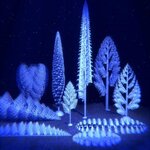Evolution

Most new species come about in geographic isolation, or at due to least large-scale geographic distance, but a controversial hypothesis known as sympatric speciation, which occurs when a new species develops while sharing the same geographic area with its parent species, may have gotten a boost in South America.
A randomly mating population in a geographical area doesn't usually reduce gene flow and speciate but sympatric speciation hypothesizes that a new niche can reduce gene flow because individuals exploit the other niche, like if herbivorous insects try out a new host plant.
A…

The small body size associated with the African pygmy phenotype is probably a selective adaptation for rainforest hunter-gatherers, according to a new study, but since all African pygmy phenotypes do not have the same genetic underpinning it is likely a more recent adaptation than previously thought, according to a new paper in the Proceedings of the National Academies of Science.
A phenotype is the outward expression of genetic makeup and while two individuals with the same phenotype may look alike, their genes may differ substantially. The pygmy phenotype exists in many parts of…

Descent with modification means that all life on Earth probably came from one common ancestor – a single-celled organism – We just have to speculate and create models for what it may have looked like, how it lived and how it evolved into today's modern cell.
So model we do and a recent paper uses mathematical modeling to speculate that life's Last Universal Common Ancestor (LUCA) had a 'leaky' membrane, which, if would, would help scientists answer two of biology's biggest questions:
1. Why all cells use the same bizarre, complex mechanism to harvest energy
2. Why two types of single-…

Rangeomorphs were unlike any modern organism, which has made it difficult to determine how they fed, grew or reproduced, and therefore difficult to link them to any particular modern group.
They looked like plants but evidence points to the fact that rangeomorphs were actually some of the earliest animals.
Starting 541 million years ago, the conditions in the oceans changed quickly with the start of the Cambrian Explosion – a period of rapid evolution when most major animal groups first emerge in the fossil record and competition for nutrients increased dramatically.
These are not plants,…

Researchers working on biomimicry have produced the first structural color change in an animal by influencing evolution: They've changed the color of the butterfly Bicyclus anynana from brown to violet - and needed only six generations of selection to do it.
Little is known about how structural colors in nature evolved, although researchers have studied such mechanisms extensively in recent years. Most attempts at biomimicry involve finding a desirable outcome in nature and simply trying to copy it in the laboratory.
The discovery published in Proceedings of the National Academy of…

Researchers have been able to experimentally reproduce
morphological changes
in mice which have taken millions of years to occur. Through small and gradual modifications in the embryonic development of mice teeth, induced in the laboratory, they obtained teeth which morphologically are very similar to those observed in the fossil registry of rodent species which separated from mice millions of years ago.
To modify the development of their teeth, the team
from the University of Helsinki and the Universitat Autònoma de Barcelona
worked with embryonic teeth cultures from mice not coded by the…

One of the most diverse families in the ocean today, marine bivalve mollusks - called Lucinidae or lucinids - originated more than 400 million years ago in the Silurian period, with adaptations and life habits like those of its modern members.
About 500 lucinid species exist today, with by far the highest diversity in shallow-sea seagrass meadows. They did it all with a little help from symbiotic friends.
At its origin, the Lucinidae family remained at very low diversity until the rise of mangroves and seagrasses near the end of the Cretaceous. Mangroves and seagrasses created…

During the winter of 1944, the Nazis blocked food supplies to the western Netherlands, creating a period of widespread famine and devastation. The impact of starvation on expectant mothers were also an epigenetic experiment — a way to monitor changes resulting from external rather than genetic influences.
The results in those families have suggested that the body's physiological responses to hardship could be inherited. If so, the underlying mechanism remained a mystery.
In a recent Cell paper, researchers explore a genetic mechanism that passes on the body's response to starvation to…

Parts of the primordial soup in which life arose have been maintained in our cells today, according to a new paper.
The articles in the Journal of Biological Chemistry
discusses how cells in plants, yeast and very likely also in animals still perform ancient reactions thought to have been responsible for the origin of life – some four billion years ago.
The primordial soup theory suggests that life began in a pond or ocean as a result of the combination of metals, gases from the atmosphere and some form of energy, such as a lightning strike, to make the building blocks of proteins which…

Models for the evolution of life are now being developed to try and clarify the long term dynamics of an evolving system of species. Specifically, a recent model proposed by Petri Kärenlampi from the University of Eastern Finland in Joensuu accounts for species interactions with various degrees of symmetry, connectivity, and species abundance. This is an improvement on previous, simpler models, which apply random fitness levels to species.
The findings demonstrate that the resulting replicator ecosystems do not appear to be a self-organized critical model, unlike the so-called Bak Sneppen…